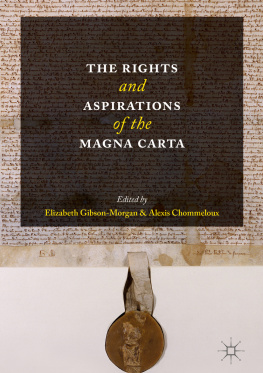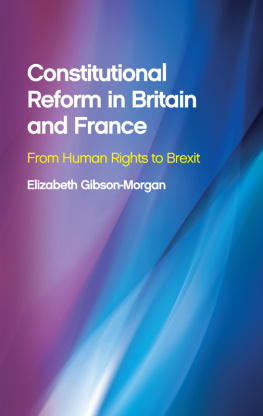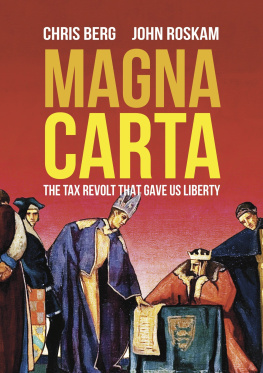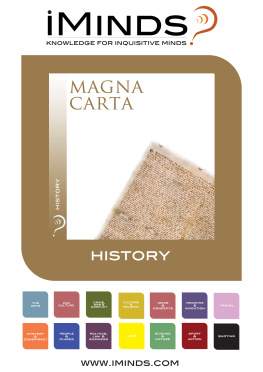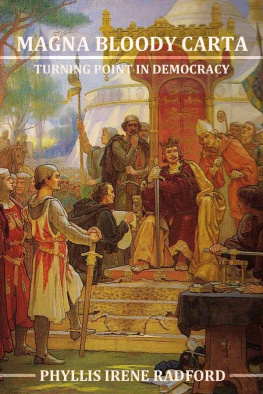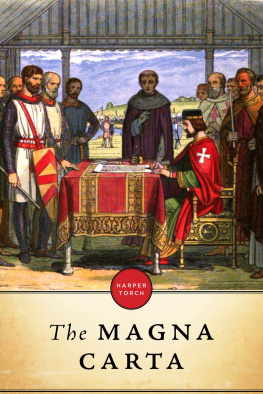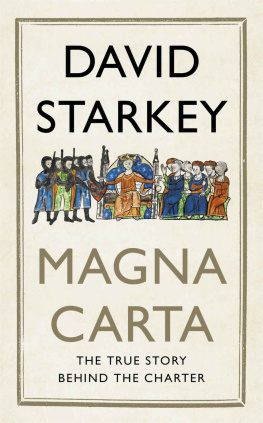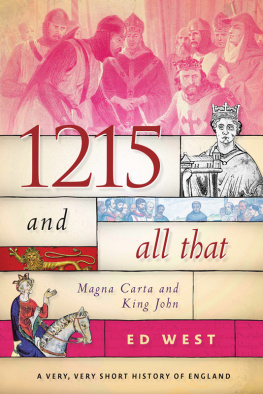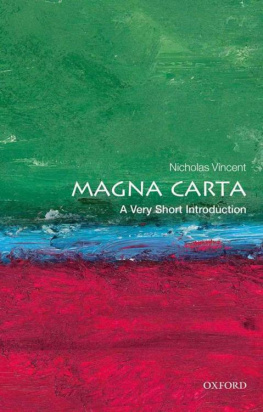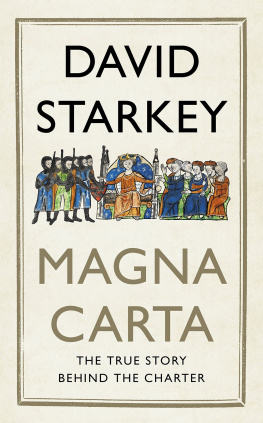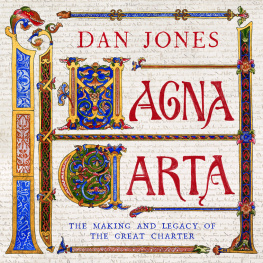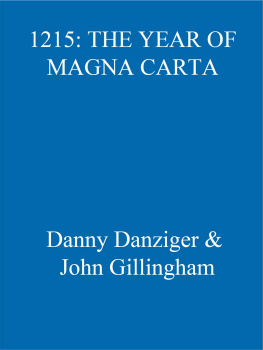1. King John, Magna Carta and the Thirteenth-Century English Church
The commemoration of the 800th anniversary of the sealing of Magna Carta at Runnymede on 15 June 2015 was attended by Her Majesty the Queen and other members of the royal family, the archbishop of Canterbury, the Prime Minister, the United States attorney general and a host of other guests and onlookers. Indeed the celebrations have reached far beyond academic circles and far beyond England. Historians of the thirteenth century enjoy unwonted celebrity status; scholarly books published in the anniversary year are pitched to appeal to wide audiences even songs, all showing how the celebration of heritage has become a social phenomenon. The commemorations have engaged with the myths surrounding Magna Carta; indeed, these, and the commemorative events themselves and the ways in which we communicate about them, have become a part of Magna Cartas history, creating as they do a record of how the Charter has been and is perceived to be relevant and precious today, in England, Europe and the wider world.
The grantor of this great charter, King John, lies in the choir of Worcester cathedral. His tomb and effigy suggest a king reconciled with his maker, prompting us to consider the nature of Johns relations with the Church. Accordingly this chapter examines Johns personal piety; the sacred nature of kingship as proclaimed in Magna Carta; the role of churchmen in counselling the king; and the issue of elections and the interdict. We examine the legacy of Magna Carta, in terms of elections and more generally in terms of ecclesiastical patronagethe kings own and those of the nobility.
Thirteenth-century chroniclers are at the root of Johns personal reputation which, despite the efforts of historians focussing on administrative rather than narrative sources to cast him in a favourable light, has generally tended to be poor.
John was genuinely devoted to certain English saints, visiting the shrines of three (St Thomas, St Alban and St Edmund), straight after his coronation.
Finally, it seems to have been Johns devotion to St Wulfstan which was the main reason why he was laid to rest inWorcester. He was the first of his dynasty to be buried in England (his parents, brother and later his wife were buried at Fontevrault), and the first king to be buried in an English cathedral since William Rufus, who was hastily interred at Winchester in 1100.
There is a contradiction at the heart of Magna Carta. It was a royal charteran affirmation of the kings right to make grants that no other person or institution could. There were sections of the Charter that affirmed royal authority or even (especially in the reissues) took it to new levels .Indeed the thirteenth century was a period in which the Crown claimed as never before that there were certain rights which it was its special prerogative to give. Yet, at the same time, Magna Carta was wrested from a king whose relationships with his barons had broken down so utterly that he was forced to make concessions that struck at the core of his monarchical and lordly power. Magna Carta needed to codify law and custom because John had disregarded them. At a time when it was becoming increasingly desirable to be in possession of munimentswritten evidence of titleit was necessary to embody the whole communitys libertiesor the limitations on royal powerin a written document. In fact the thirteenth century was a period in which a number of European rulers granted charters of liberties to their subjects. For example, the Statute of Pamiers was granted in 1212 by Simon de Montfort, leader of the crusade against the Albigensian heretics, to establish laws for the crusader state of Toulouse.
The preamble to the Charter recognised the kings rule under God and addressed the influential in the kingdom, both ecclesiastical and secular, and the hierarchy of royal ministers :
John, by the grace of God, king of England, lord of Ireland, duke of Normandy and Aquitaine, count of Anjou, to his archbishops, bishops, abbots, earls, barons, justices, foresters, sheriffs, reeves, ministers, and all his bailiffs and faithful men, greeting.
The charter proceeded to explain the kings motives and intent:
inspired by God and for the salvation of our soul, and for the souls of all our ancestors and heirs, for the honour of God and the exaltation of holy church, and the reform of our kingdom.
Thus the preamble affirmed the sacred nature of medieval kingship and associated the spiritual standing of the king with the political state of his realm. The idea was not of course new, but Johns reign had experienced the harsh realities of the link in the period of the interdict which Pope Innocent III had imposed on England in 1208. The interdictspiritual sanctions on a country or region, depriving its inhabitants of the benefits of the sacraments of the Church (with some few exceptions) had been imposed because of Johns refusal to accept Stephen Langton as archbishop of Canterbury. Indeed, the political messages in the popes letters, which form a uniquely valuable source for our understanding of the relationships between England and the papacy in this crucial period, use spiritual language throughoutthat of the spiritual father correcting the transgressions of a wayward but much beloved son in order to persuade him to return to the path of political obedience. The sphere of spiritual authoritythe boundary to the popes power over himwas, of course, precisely the issue. According to the Burton annals, John, when meeting with the papal legates at Northampton in 1211, told them:
I admit that the lord pope is my spiritual father, and that he is in the place of Blessed Peter, and that I must obey him, that is, in spiritual matters; but in earthly things which belong to my crown, never.
The very layout of Magna Carta symbolises the difficulties of drawing those boundaries: its first main clause granted the Church its liberties and thus appeared to treat the clergy separately from the rest. Between the clause granting liberty to the Church was another brief preamble introducing the liberties of all free men, as though these were another category entirely. Yet, bishops and abbots were great landowners under the Crown and owed military service to the king. Clauses in Magna Carta affecting landowners affected them too. Clause 60 of the charter required all men, both clerks and laymen, to observe the liberties granted in Magna Carta towards their own men; and clause 62 pardoned all the ill will, indignation and rancour between the king and his men, clerk and lay.
The preamble proceeded to explain on whose counsel the charter had been given. These included a number of named churchmenthe archbishop of Canterbury, Stephen Langton, Henry, archbishop of Dublin, and the bishops of London, Winchester, Bath and Glastonbury, Lincoln, Worcester, Coventry and Rochester. There was the Master Pandulf, member of the papal household, symbolising the continued presence of papal support for John, and Aymeric, master of the Knights of the Temple in England and the kings banker. Their names were followed by those of earls, barons and other laymen. Some of these were the kings firm supporters and ministers, while othersmost obviously Langton himselfwere there as mediators seeking an end to the political disturbances.
It is not surprising to see the bishops included in the list of the kings counsellors. Churchmen were supposed to be mediators, a point which was made time and again by Innocent III. He had written to Stephen Langton and his fellow bishops, and also to abbots and priors and other prelates on the appointment of Nicholas, cardinal bishop of Tusculum, as papal legate to England in July 1213 after the interdict, and had instructed them to promote the cause of peace in every way they could.

